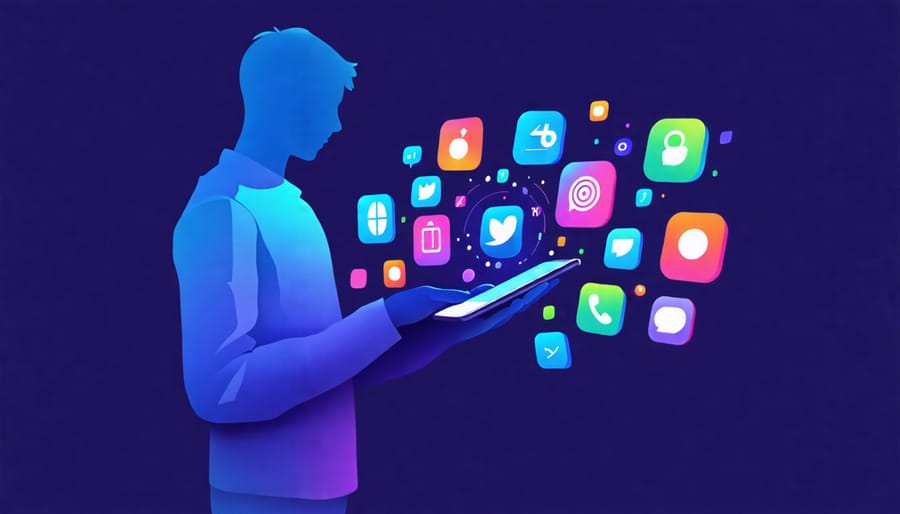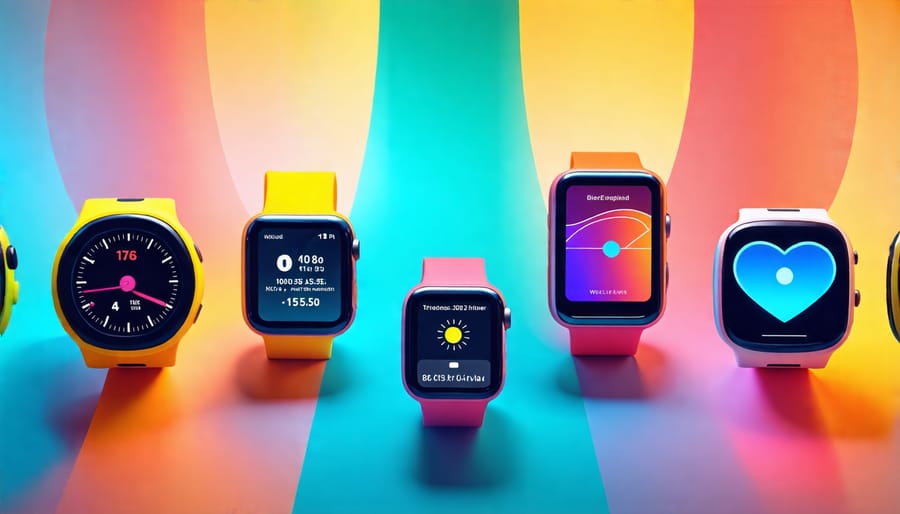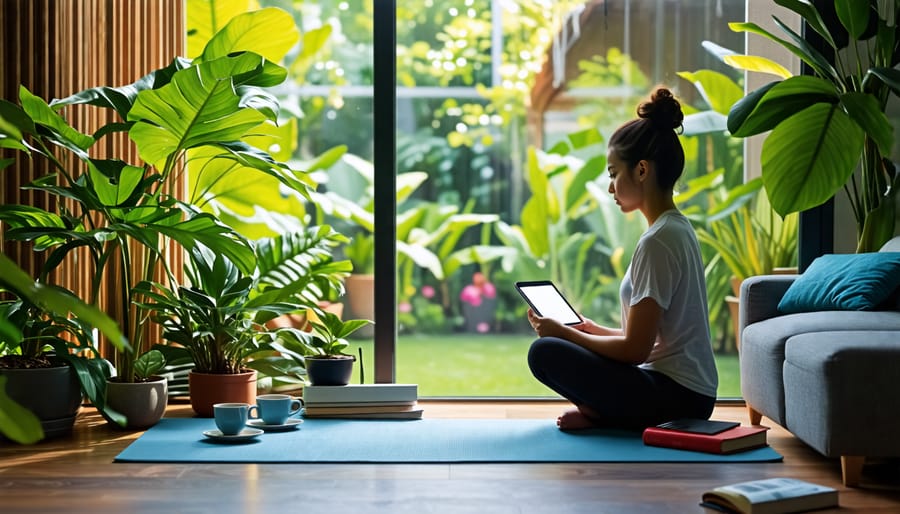Set clear digital boundaries by designating device-free times, such as during meals or an hour before bed, to support your digital wellness. Use apps and features like screen time trackers, website blockers, and “do not disturb” modes to manage your tech habits. Prioritize quality sleep by keeping devices out of the bedroom and maintaining a regular sleep schedule.

Set Digital Boundaries
In today’s constantly connected world, setting digital boundaries is crucial for maintaining a healthy balance between technology and wellness. Limiting screen time, especially before bedtime, can improve sleep quality and reduce the risk of digital eye strain. Turning off notifications for non-essential apps and designating specific times to check emails or social media can help minimize distractions and increase productivity.
Disconnecting regularly is another key aspect of digital well-being. Consider implementing a “digital detox” day once a week, where you completely unplug from electronic devices and engage in offline activities like reading, spending time outdoors, or connecting with loved ones face-to-face. During workdays, take short breaks every hour to stand up, stretch, and give your eyes a rest from the screen.
To make setting tech boundaries easier, try using built-in features like Apple’s Screen Time or Android’s Digital Wellbeing to track your device usage and set app limits. Physically distancing yourself from your phone or tablet by leaving it in another room while you focus on work or engage in leisure activities can also be effective. Remember, the goal is not to eliminate technology entirely, but rather to use it mindfully in a way that supports your overall health and happiness.
Use Apps and Wearables Wisely
Health and fitness apps, meditation apps, and wearable devices can be powerful tools to support your wellness goals when used mindfully. Top-rated apps like MyFitnessPal, Calm, and Headspace provide valuable features such as nutrition tracking, guided meditations, and stress reduction techniques. Wearable devices like Fitbit and Apple Watch can track your physical activity, heart rate, and sleep patterns, helping you stay accountable and motivated.
However, it’s important to avoid over-relying on these tools. While they can complement your wellness journey, they shouldn’t replace professional medical advice, self-awareness, or intrinsic motivation. Use them to gain insights and establish healthy habits, but also practice listening to your body’s cues and enjoying activities for their inherent value, not just the metrics.
Aim for a balanced approach that leverages technology’s benefits while maintaining a healthy perspective. Set realistic goals, celebrate your progress, and don’t get discouraged by temporary setbacks. Remember, apps and wearables are meant to enhance your well-being, not induce stress or obsession. If you find yourself becoming overly fixated on the numbers or experiencing anxiety, take a step back and reevaluate your relationship with these tools. Prioritize sustainable, enjoyable lifestyle changes that technology can support but not control. With mindful usage, apps and wearables can be valuable allies on your path to optimal wellness.

Prioritize Good Sleep Hygiene
Technology can significantly impact the quality and quantity of your sleep. The blue light emitted by digital screens suppresses melatonin production, making it harder to fall asleep and disrupting your natural sleep-wake cycle. Late-night scrolling, notifications, and digital stimulation can also keep your mind alert and engaged, preventing you from fully relaxing before bed.
However, when used mindfully, technology can actually support better sleep. Start by setting your devices to automatically filter out blue light in the evenings, which can help regulate your circadian rhythm. Consider using a sleep tracking app or wearable device to gain insights into your sleep patterns and identify areas for improvement.
Establishing a digital winddown routine is also crucial for sleep hygiene. Aim to disconnect from screens at least an hour before bed, and instead engage in calming activities like reading, gentle stretching, or journaling. If you must use technology close to bedtime, opt for relaxing content like guided meditations or soothing soundscapes.
Remember, while technology can be a valuable tool, it’s essential to set boundaries and prioritize restful, restorative sleep. By being mindful of your digital habits and leveraging tech to support healthy sleep routines, you can harness the power of technology to enhance your overall wellness and vitality.

Balance Screen Time with Green Time
In today’s digital age, it’s easy to get caught up in screens and forget the importance of connecting with nature. Spending time outdoors offers numerous mental health benefits, including reduced stress, improved mood, and enhanced cognitive function. To strike a healthy balance between technology use and green time, aim to dedicate a portion of each day to outdoor activities like walking, gardening, or simply enjoying a park.
If you find it challenging to disconnect from your devices, consider using nature-focused apps that encourage outdoor exploration. Plant identifier apps can help you learn about the flora around you, while hiking trail finders can guide you to new and exciting routes. By using technology to facilitate your nature time, you’ll be more likely to prioritize these healthy habits.
Remember, the goal isn’t to eliminate technology entirely but rather to find a balance that allows you to enjoy its benefits without compromising your well-being. Start small by setting aside dedicated tech-free time each day, and gradually increase your nature time as it becomes a more integral part of your routine. With a balanced approach, you can harness the power of both technology and nature to support your overall health and wellness.
Make Your Tech Setup Ergonomic
Optimizing your technology setup is essential for maintaining physical comfort and avoiding strain. Start by positioning your computer monitor at eye level, about an arm’s length away, to prevent neck and eye strain. Invest in an ergonomic office chair that supports your lower back and promotes good posture. When typing, keep your wrists straight and elbows at a 90-degree angle to minimize wrist strain. Consider using an external keyboard and mouse to allow for more natural arm and hand positioning. Take regular breaks to stand, stretch, and move around, preventing muscle fatigue and promoting circulation. Incorporating ergonomic accessories like a footrest, wrist rest, or standing desk can further enhance your comfort. By making these simple adjustments to your tech setup, you can significantly reduce the risk of developing repetitive strain injuries and maintain your overall physical well-being while using technology.
Technology can be a powerful tool for supporting our health and wellbeing when used mindfully. By setting digital boundaries, utilizing wellness apps, prioritizing sleep, spending time in nature, and maintaining proper ergonomics, we can harness the benefits of technology while minimizing its potential drawbacks. Remember, small changes in your daily tech habits can make a big difference over time. As you move forward, be intentional about how and when you engage with your devices. Seek out apps and tools that enrich your life and support your wellness goals. Most importantly, listen to your mind and body – they’ll tell you when it’s time to unplug and recharge. With a balanced approach, technology can be a positive force in your journey towards optimal health and happiness.

